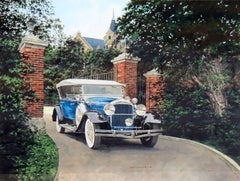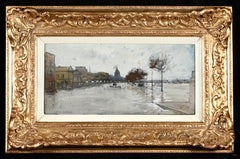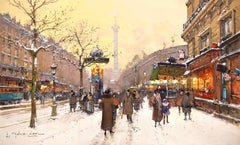James Deenen Art
to
1
1
1
Overall Height
to
Overall Width
to
1
1
1
1
1
6,886
3,222
2,514
1,217
1
1
1
1
Artist: James Deenen
1929-1930 Hudson Dual Cowl Phaeton
By James Deneen
Located in Fort Washington, PA
Medium: Gouache on Board
Dimensions: 18.00" x 25.00"
Signature: Lower Center
Category
20th Century James Deenen Art
Materials
Gouache, Board
Related Items
The Great Flood of Paris - Impressionist Landscape Gouache Painting - Luigi Loir
By Luigi Loir
Located in Marlow, Buckinghamshire
Signed gouache on board impressionist landscape by French painter Luigi Loir. This work depicts the famous flood of Paris in 1910 when the Seine broke its banks in the largest flooding the city had seen in a 100 years. Loir likely painted this work "en plein air" as he encountered this rare natural occurrence.
Signature:
Signed lower left
Dimensions:
Framed: 13"x19"
Unframed: 5"x11"
Provenance:
Private French collection
He first exhibited at the Paris Salon in 1865 with a Landscape at Villiers-sur-Seine which brought him a certain amount of recognition. He was a regular exhibitor at the Salon des Artistes Français. Obtaining a third-place medal in 1879, and a second-place medal and a gold medal in 1889 at the Exposition Universelle in Paris. He was decorated with the Légion d'Honneur in 1898.
Born in Austria to French parents who served the exiled French Bourbon royal family, Luigi Aloys-François-Joseph Loir moved with his family and the Bourbons to the Duchy of Parma in 1847. In 1860 his family returned to Paris following the expulsion of the Bourbons from Parma. But Luigi remained in the city, having enrolled, at the young age of eight, at the Accademia de Belle Arti. He eventually rejoined his family in Paris in 1863. There he studied with the decorative painter and set designer Jean Pastelot, making his Salon debut in 1865. Loir painted mainly views of Paris, in all seasons and at different times of the day or night.
Loir was the Paris painter...
Category
Early 20th Century Impressionist James Deenen Art
Materials
Gouache, Board
Place de la Bastille - Impressionist Snowy Cityscape by Eugene Galien-Laloue
By Eugene Galien-Laloue
Located in Marlow, Buckinghamshire
Signed impressionist gouache on board circa 1890 by sought after French painter Eugene Galien-Laloue. The piece depicts a depicting a bustling city scene at the Place de Bastille in ...
Category
1890s Impressionist James Deenen Art
Materials
Board, Gouache
1880s Original Hudson River School Landscape -- Sunset Through The Forest
By Charles Russell Loomis
Located in Soquel, CA
Beautiful Hudson River School Original gouache autumnal landscape of vivid sunset through forest by Charles Russell Loomis (American 1857 - 1936), circa 1880. Warm and cool tones wit...
Category
1880s Hudson River School James Deenen Art
Materials
Gouache, Paper, Cardboard
Simka Simkhovitch WPA Artist Oil Painting Gouache American Modernist Powerline
By Simka Simkhovitch
Located in Surfside, FL
Simka Simkhovitch (Russian/American 1893 - 1949)
This came with a small grouping from the artist's family, some were hand signed some were not.
These were studies for larger paintings.
Simka Simkhovitch (Симха Файбусович Симхович) (aka Simka Faibusovich Simkhovich) (Novozybkov, Russia May 21, 1885 O.S./June 2, 1885 N.S.—Greenwich, Connecticut February 25, 1949) was a Ukrainian-Russian Jewish artist and immigrant to the United States. He painted theater scenery in his early career and then had several showings in galleries in New York City. Winning Works Progress Administration (WPA) commissions in the 1930s, he completed murals for the post offices in Jackson, Mississippi and Beaufort, North Carolina. His works are in the permanent collections of the Dallas Museum of Art, the National Museum of American Art and the Whitney Museum of American Art. Born outside Kyiv (Petrograd Ukraine) into a Jewish family who owned a small department store. During a severe case of measles when he was seven, Simcha Simchovitch sketched the views outside his window and decided to become an artist, over his father's objections. Beginning in 1905, he studied at the Grekov Odessa Art School and upon completion of his studies in 1911 received a recommendation to be admitted to the Imperial Academy of Arts. Though he enrolled to begin classes in architecture, painting, and sculpture at the Imperial Academy, he was dropped from the school roster in December because of the quota on the number of Jewish students and drafted into the army. Simchovitch served as a private in the 175th Infantry Regiment Baturyn [ru] until his demobilization in 1912. Re-enrolling in the Imperial Academy, he audited classes.
Simka Simkhovitch exhibited paintings and sculptures in 1918 as part of an exhibition of Jewish artists and in 1919 placed 1st in the competition "The Great Russian Revolution" with a painting called "Russian Revolution" which was hung in the State Museum of Revolution. In 1922, Simkha Simkhovitch exhibited at the International Book Fair in Florence (Italian: Fiera Internazionale del Libro di Firenze). In 1924, Simkhovitch came to the United States to make illustrations for Soviet textbooks and decided to immigrate instead. Initially he supported himself by doing commercial art and a few portrait commissions. In 1927, he was hired to paint a screen for a scene in the play "The Command to Love" by Fritz Gottwald and Rudolph Lothar which was playing at the Longacre Theatre on Broadway. Art dealers began clamoring for the screen and Simkhovitch began a career as a screen painter for the theater. Catching the attention of the screenwriter, Ernest Pascal, he worked as an illustrator for Pascal, who then introduced him to gallery owner, Marie Sterner. Simkhovitch's works appeared at the Marie Sterner Gallery beginning with a 1927 exhibit and were repeated the following year. Simkhovitch had an exhibit in 1929 at Sterner's on circus paintings. In 1931, he held a showing of works at the Helen Hackett Gallery, in New York City and later that same year he was one of the featured artists of a special exhibit in San Francisco at the California Palace of the Legion of Honor in Lincoln Park. The exhibit was coordinated by Marie Sterner and included four watercolors, including one titled "Nudes". He is of the generation of Russian Soviet artists such as Isaac Pailes, Serge Charchoune, Marc Chagall, Chana Orloff, Isaac Ilyich Levitan, and Ossip Zadkine.
In 1936, Simkhovitch was selected to complete the mural for the WPA Post office project in Jackson, Mississippi. The mural was hung in the post office and courthouse in 1938 depicted a plantation theme. Painted on the wall behind the judge’s bench, “Pursuits of Life in Mississippi”, a depiction of black workers engaged in manual labor amid scenes of white professionals and socialites, was eventually covered over in later years during renovations due to its stereotypical African American imagery. Simka painted what he thought was typical of Jackson. His impression of pre-civil rights Mississippi was evidently Greek Revival column houses, weeping willow trees, working class families, and the oppression of African Americans. He painted African American men picking cotton, while a white man took account of the harvest and a white judge advised a white family, calling it Pursuits of Life in Mississippi.
Though clearly endorsed by the government and initially generally well-received, the mural soon raised concerns with locals as the climate toward racial segregation began to change. The main concern was whether depictions that show African Americans in subjugated societal roles should be featured in a courtroom. The following year, his painting "Holiday" won praise at an exhibition in Lincoln, Nebraska. In 1940, Simkhovitch's second WPA post office project was completed when four murals, "The Cape Lookout Lighthouse and the Orville W. Mail Boat", "The Wreck of the Crissie Wright", "Sand Ponies" and "Canada Geese" were installed in Beaufort, North Carolina. The works were commissioned in 1938 and did not generate the controversy that the Jackson mural had. The main mural is "The Wreck of the Crissie Wright" and depicts a shipwreck which had occurred in Beaufort in 1866. "The Cape Lookout Lighthouse and the Orville W. Mail Boat" depicted the lighthouse built in 1859 and the mail boat that was running mail during the time which Simkhovitch was there. The boat ran mail for the area until 1957. "Sand Ponies" shows the wild horses common to the North Carolina barrier islands and "Canada Geese" showed the importance of hunting and fishing in the area. All four murals were restored in the 1990s by Elisabeth Speight, daughter of two other WPA muralists, Francis Speight...
Category
1930s American Modern James Deenen Art
Materials
Gouache, Oil, Board
Les Baux de Provence.
Located in Cotignac, FR
Late 20th century gouache landscape of "Les Baux de Provence" on paper by French artist Désiré Villain, signed bottom left and to the reverse and dated 199...
Category
Late 20th Century Impressionist James Deenen Art
Materials
Paper, Gouache, Board
Orange Grove Landscape
By Dorr Bothwell
Located in Los Angeles, CA
Orange Grove Landscape, 1941, gouache on illustration board, 14 inches x 18 inches (image), 22 x 26 inches (framed) signed and dated lower right, newly framed with museum glazing
...
Category
1940s American Modern James Deenen Art
Materials
Gouache, Board
Hotel Futura Illustration
By Joseph Binder
Located in Miami, FL
Men Who Plan Beyond Tomorrow” Advertising campaign for
The world’s incredible technological inventions that we take for granted today …..
Provenance: Edgar Bronfman Sr. former C...
Category
1940s Futurist James Deenen Art
Materials
Illustration Board, Gouache
Arabian Nights, Sea Monster - The Thousand and One Nights
By Gustaf Tenggren
Located in Miami, FL
Arabian Nights, Sea Monster - The Thousand and One Nights Gustaf Tenggren - Attributed - unsigned, unframed. Good condition with very slight toning.
Category
1940s Art Deco James Deenen Art
Materials
Gouache, Illustration Board
Late 19th Century Original English Landscape of a Cottage in Cambria
Located in Soquel, CA
Late 19th Century Original English Landscape of a Cottage in Cambria
Wonderful original antique painting of a thatched cottage in Cambria by Thomas Noelsmith (English, 1840-1900), c...
Category
1880s Impressionist James Deenen Art
Materials
Gouache, Illustration Board
H 10.5 in W 13.5 in D 2 in
Pulp Magazine Marine Combat Scene Shoot Out in Blue Noir
Located in Miami, FL
What makes this work important?
It's not that it's a commissioned artwork for a men's 60s pulp adventure magazine depicting the instant a soldier is shot. The big point of the painting is how brilliantly the formal elements are thought out, designed, and executed. John McDermott tells a story using a complex figural composition in an unexpected wide-angle vision. The work is as abstract as it is representation. His use of light is significant because it creates a high-contrast two-color style that bears the mark of its creator. This is a work done by a master artist/illustrator without peers compared to artists living today. If the contemporary art world gave awards for draftsmanship, painting technique, and graphic design .... John McDermott would win the highest accolades.
Initialed lower left - unframed
John McDermott (August 30, 1919 – April 20, 1977), also known under the pen names J.M. Ryan and Mariner, was an American illustrator and author noted for action and adventure illustrations.[1] McDermott worked as an in-between and effects animator for Walt Disney Studios and as a US Marine combat artist,before establishing himself as a cover illustrator for 1950s paperbacks and pulp magazines such as Argosy, American Weekly, and Outdoor Life. Under his J.M. Ryan pen name, he wrote the novels The Rat Factory (1971), a derogatory satire of Walt Disney and the Disney studio; Brooks Wilson Ltd (1967), on which the 1970 film Loving was based; and Mother's Day (1969) about Ma Barker. Under his own name, he novelized director-writer Bo Widerberg's screenplay for the 1971 film Joe Hill, which would be his final published book.
Early life
John Richard McDermott was born 30 August 1919 in Pueblo, Colorado, the younger of two sons of Henry McDermott, an oil broker. McDermott was a young child when his father committed suicide.[4] The family eventually moved to Los Angeles where McDermott's mother, Hazel, worked in a beauty parlor. He graduated from Hollywood High School in 1936. Although he had had no formal art education, he took a job as an artist at Walt Disney Animation Studios.
Career
Disney
At Disney, McDermott worked as an in-betweener and effects animator on Brave Little Tailor, Pinocchio, The Reluctant Dragon and Fantasia. His experiences while working at Disney, particularly during the time of the 1941 Disney animators' strike, would later become the basis for his 1969 satirical novel The Rat Factory. McDermott left Disney to fight with US forces during World War II.
US Marines
McDermott World War II sketch titled "Buddy is Wounded"
On September 29, 1942, McDermott enlisted with the US Marine Corps. He served as a "pistol and palette" combat artist assigned to the map-making section. As a sergeant with the III Amphibious Corps, McDermott was involved in battles in the South Pacific theater of war, documenting the Guam, Okinawa and the Guadalcanal Campaigns. McDermott considered his wartime years to be his art education.
"In the Marines, as a combat artist, I traveled with the troops and for three years got all the drawing opportunity anyone could want. My work changed enormously during this time and I’m sure it was due to constant drawing, every single day, from life, just putting down what I saw around me. In a few instances it was a dangerous kind of scholarship."
According to the Marine Corps history journal Fortitudine, McDermott was so prolific that his contemporary style pen-and-ink sketches became easily recognizable to both Marines, from published work in Leatherneck Magazine, and civilians, from glossy copies supplied by the Marine Corps to the nation's press.His wartime art appears in World War II history books and is displayed at the Pentagon and the National Museum of the Marine Corps.
Illustration
Following the end of World War II, McDermott moved from California to New York City to work as a freelance illustrator. McDermott made his reputation drawing modern action, war and adventure scenes. His work adorned the covers and inside story pages of popular pulp magazines of the 1950s such as Argosy, Adventure, Blue Book, Outdoor Life and American Weekly.
McDermott's illustrations appeared on numerous covers of 1950s paperback novels published by Dell, Fawcett Gold Medal, Bantam Mystery and others. His action graphics were geared toward thriller and detective genres, such as Donald Hamilton's Matt Helm books Murderers' Row and The Betrayers. He also created covers for science fiction comic titles such as Voyage to the Deep[citation needed] and horror-themed paperbacks such as the classic 1955 science fiction novel The Body Snatchers...
Category
1960s American Realist James Deenen Art
Materials
Illustration Board, Gouache
H 18.6 in W 20.2 in D 1 in
Airacuda Fighter Planes Art Deco Machine Age 20th Century American Modernism
Located in New York, NY
Airacuda Fighter Planes Art Deco Machine Age 20th Century American Modernism
Arthur Rosenman Ross (1913 - 1981)
Bell YFM-1 Airacuda Fighter Planes
17 1/2 x 26 1/2 inches
Gouache, Airbrush and Ink on Illustration Board, 1938
Signed A. Ross lower right
Provenance: Estate of the artist.
BIO
Arthur Rosenman Ross was a key figure in automotive design at General Motors during America's "Golden Age" of auto design, the 1930's through the 1950s.
He attended the Art Institute of Chicago from age 17, exhibiting a special interest for automotive renderings and the female figure.
In 1934, he changed his name from Rosenman to Ross, fearing his Jewish ancestry could prejudice his career prospects. At age 20, he turned down job offers from MGM Studios in Hollywood
and Duesenberg to work at General Motors alongside the Legendary Harley Earl in 1935.
He was hand picked by Mr. Earl and assigned to GM's War and Camouflage Division in 1937 through WW2.
It was during this pivotal period in which he executed some extraordinary military aircraft artworks, likely used between GM and America's military aeronautics companies in design preparation for WW2. General Motors played an important role in helping America's aircraft manufacturers preceding and during the war.
Just after the war in 1945, Mr. Ross was rewarded by GM, being made Chief Designer of Cadillac, then two years later becoming Chief at Oldsmobile until his retirement in 1959.
He was in large part responsible for some of GM's classic Cadillac designs such as the Cadillac Sixty Special, Fleetwood, LaSalle and GM's first concept car, the extraordinary Buick Y-Job.
Mr. Ross was an exceptionally charismatic and vivacious man who quite by chance, befriended His idol, Salvador Dali at GM in 1955.
They talked about art, cars and girls late into the evening, according to his son, Carter Ross.
He had a gift in rendering the erotic arts...
Category
1930s American Modern James Deenen Art
Materials
Ink, Gouache, Board
Thought Provoking Rock Quarry - Mid Century Abstract
Located in Miami, FL
This meticulously planned, designed, and executed work depicts an ultra-wide angle view of a rock quarry/mine. The viewer looks down at close-up-stylized rock formations and then ou...
Category
1950s Abstract Expressionist James Deenen Art
Materials
Mixed Media, Gouache, Board
James Deenen art for sale on 1stDibs.
Find a wide variety of authentic James Deenen art available for sale on 1stDibs. You can also browse by medium to find art by James Deenen in board, gouache, paint and more. Not every interior allows for large James Deenen art, so small editions measuring 25 inches across are available. Customers who are interested in this artist might also find the work of Harriet Holden Nash, Eugene Pechaubes, and Charles Cobelle. James Deenen art prices can differ depending upon medium, time period and other attributes. On 1stDibs, the price for these items starts at $2,900 and tops out at $2,900, while the average work can sell for $2,900.


